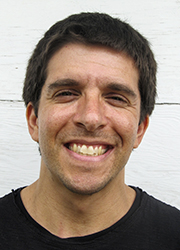q & a: kyle dreyfuss-wells, manager of watershed programs, neorsd
When stormwater runs off streets, parking lots, lawns and other sites, where does it go?
This is not an existential question, but rather a serious environmental issue for developed areas like Cleveland, which are paved over with impervious surfaces that prevent precipitation from seeping naturally into the ground. Stormwater can overflow sewers, flood homes, erode roads and streambanks, and pollute waterways like that large body of blue hugging the Cleveland shoreline.
The Northeast Ohio Regional Sewer District (NEORSD) is seeking to address these issues with its regional stormwater management program. The enterprise establishes a system of watercourses, stormwater conveyance structures and control measures throughout a service area that receives drainage from 350 square miles of land. The sewer district has identified more than $228 million of needed construction projects. Detailed planning on some projects has already begun.
This is a course of action that NEORSD officials believe is long overdue. As its name suggests, the program is maintained by the public, crossing community borders through a watershed-based approach.
Fresh Water's Douglas J. Guth spoke with Kyle Dreyfuss-Wells, manager of watershed programs for NEORSD, about what the venture means for the average eco-conscious resident.
How does the regional stormwater program work?
We will collect a fee based on the amount of hard surface on commercial and residential properties, generating about $35 million annually to resolve flooding and erosion problems. Warner Road in Garfield Heights, for example, is threatened by erosion from Mill Creek. Doan Brook at Rockefeller Park has flooding and erosion problems.
These are large, chronic issues that no individual community is responsible for, which is why we're implementing a regional solution. The program applies to the entire stormwater service area, including most of Cuyahoga County as well as portions of Lake, Summit and Lorain counties. We are a water-rich region of lakes and rivers, and so have a significant amount of surfaces that add sediment and other pollutants. If we want fresh water, we have to manage our stormwater.
What are the benefits of the program?
This is a holistic look at stormwater to fix problems in a cost-effective way. This has not been done before. Previously, stormwater has been dealt with from community to community, resulting in "upstream communities" moving their issues downstream. As far as immediate benefits, the sewer district staff is removing debris from pipes, culverts and large streams to minimize flooding. That's happening right now.
How does the proposed 'stormwater fee' apply to residents?
The new charge will appear on a homeowner's water and sewer bill directly proportional to the impervious surface on the property. We have geographic information technicians who have used aerial photos to trace out impervious surfaces on almost every parcel of land.
The average homeowner within the sewer district's service area will be charged $5.05 per month, or $60.60 per year, to pay for stormwater-related construction projects and maintenance. We have grouped residential properties into three tiers, with one "residential unit" equal to 3,000 square feet of impervious surface. People can go to our website and figure out their fee.
What is a 'stormwater fee credit' and how can homeowners get it?
People can receive a reduction in their stormwater fee through stormwater fee credits. The credit recognizes on-site practices that reduce runoff from the property into the regional stormwater system. There is a series of control measures that we take into account for single-family residences. These can include rain gardens, vegetated filter strips, rain barrels, installation of pervious pavement, or impervious surface reductions. The credit ranges from a 25 percent reduction of the fee up to 100 percent if you're doing full stormwater management.
The key thing people should know is that any onsite stormwater management relies on people disconnecting their downspout. Many local residents already have downspouts running [water] over their grass. We have technical support to help with any questions people may have.
How can you get people to think about stormwater on an everyday basis?
We're helping residents understand that what they do on their property is connected to the quality of the region's water. I'm amazed by how many people are already thinking about this. There is such creativity and inventiveness here from people who have connected downspouts to yards, or have rain barrels or cisterns. We've had public meetings where people are telling us how they've managed their stormwater, and it's been very impressive.
Some people are doing the opposite, draining water off their property so the runoff is faster. That's not something we want to encourage. But we do have an educated populace that really gets this. We're also raising awareness about impervious surfaces, which is an education itself. The sewer district isn't the only player, either. We have seven watershed organizations supporting what we do and doing great work with communities. It's a ripple effect.
What kind of stormwater management are you doing on your own property?
My family built a new house in Shaker Heights with disconnected downspouts, a huge rain garden and a large swale on a meadow. It's kind of ridiculous. We have it all.
Photos Bob Perkoski








